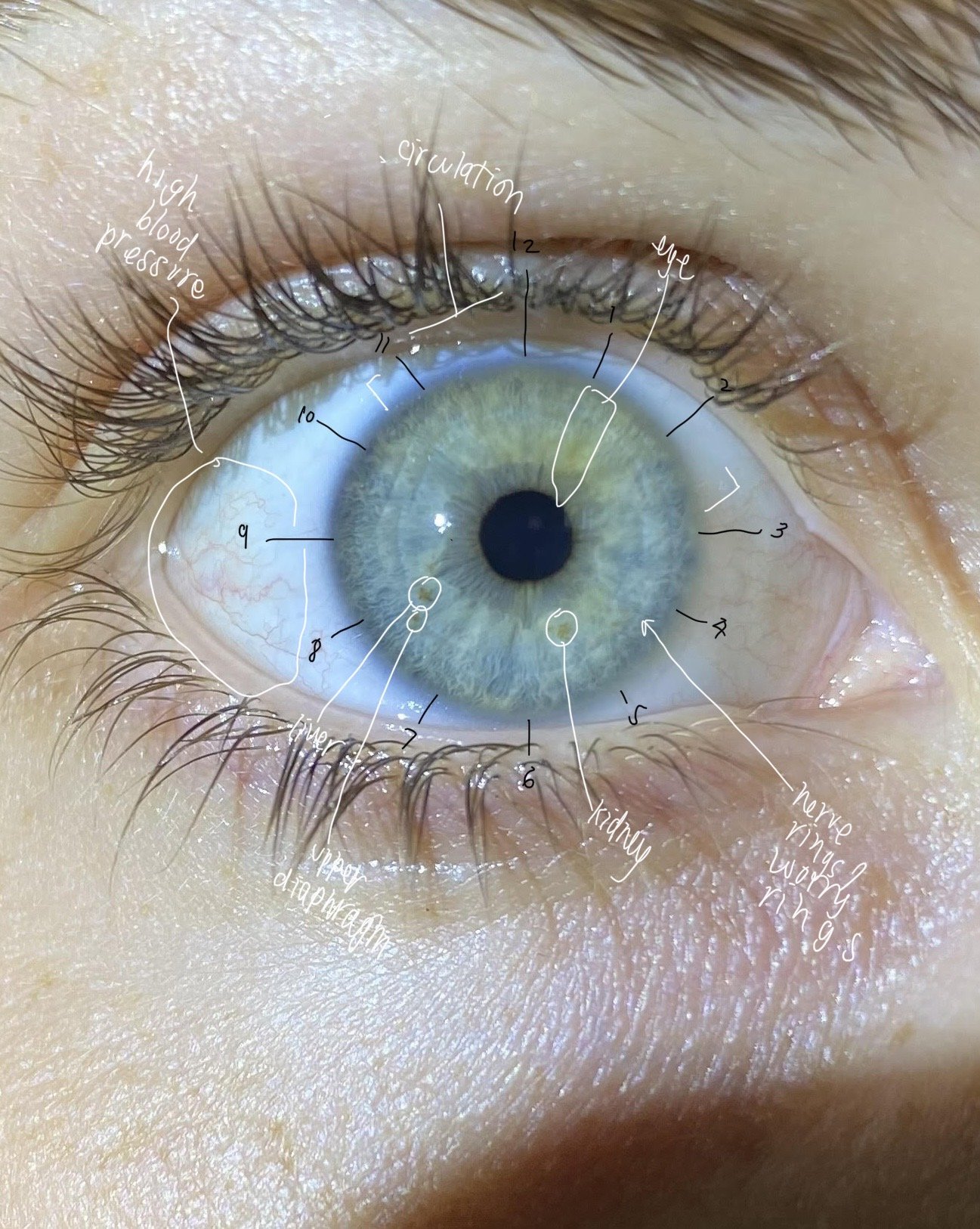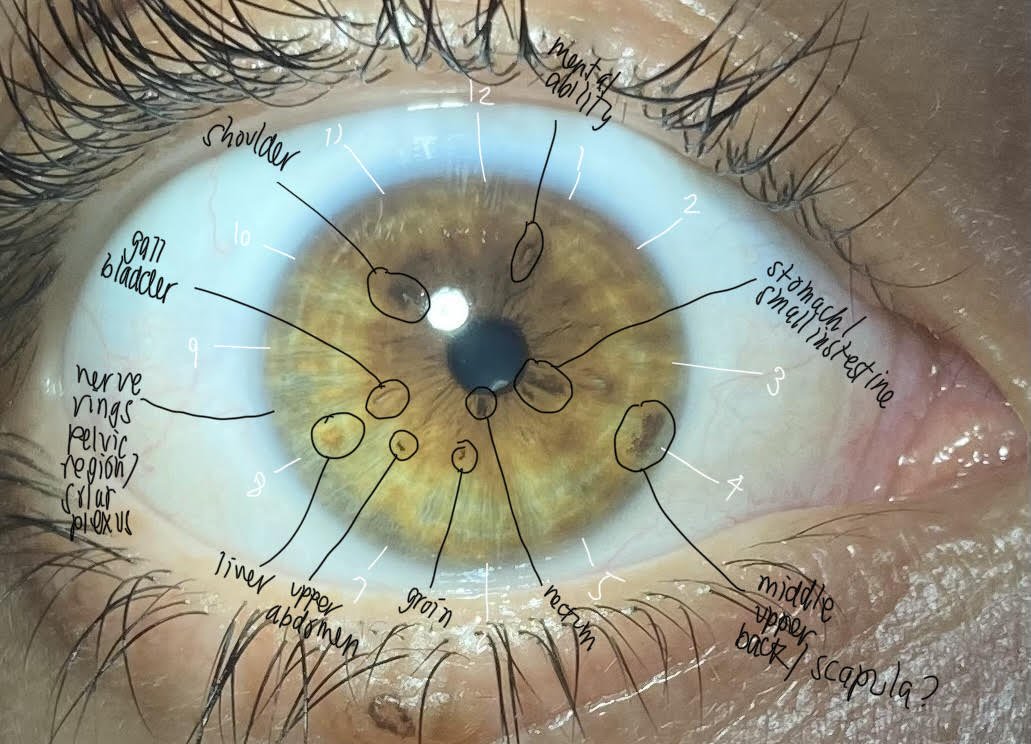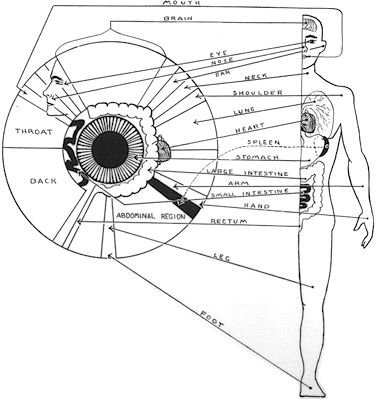
THE PRACTICE OF IRIDOLOGY
SCROLL ALL THE WAY TO THE BOTTOM TO BOOK AN DETAILED IRIDOLOGY ANALYSIS WITH ME!
The iris of the eye is the most complex tissue of the body meeting the outside world. It is an extension of the brain, being incredibly endowed with hundreds of thousands of nerve endings, microscopic blood vessels, muscle and other tissues. Your iris is literally connected to every organ and tissue in your body via the brain and the central nervous system. Because of this.. nature has seemed to have provide us with a miniature television screen showing us a direct reflection of the deepest parts of our body by way of nerve reflex responses. Iridology; the study of the iris.. is the most effective, natural, and accurate diagnostic tool that the body offers. Many of us don’t think twice about the colors and patterns of our eyes and think they just look “cool” or “have different “dots” and bright orange colors for “no reason”. But really, each and every persons iris pattern reflects a perfect map to the body and has the capability to show us any / all disease, disturbances, genetic weaknesses, and discord in the body. Iridology is used as a helpful preventative tool so that we can bring awareness to the parts of our body that need detoxification, purification, and healing.
Iridology, has been traced as far back as 400 BC and was practiced by Hippocrates and Philostratus and was taught at the Medical School of Salerno. The Chaldeans of Babylonia, in 1000 B.C., left records of iris markings with the relevant anatomical reflexes painted on stone slabs. The first explicit description of iridological principles such as homolaterality are found in Chiromatica Medica, a famous work published in 1665 by Philippus Meyeus. In the 17th, 18th and 19th centuries, writings and works on iris markings and their meanings were recorded, mainly by medical practitioners.
Within the iris a story unfolds: areas of strength and fragility, our lives and the footsteps of our ancestors are reflected in the iris. The iris offers insight into the conditions of the cells, tissues, organs, systems and glands, providing information such as genetic predispositions, tissue inflammation, toxicity and areas of tissue stress; used as a diagnostic tool used in conjunction with natural health modalities. Often the treatment consists of an herbal protocol, detoxification program, and other natural healing methods including massage, chiropractic, or acupuncture.
In the embryonic stage of development the iris was part of the brain. The iris shows the end result of nerve transmissions to the brain from all organs and systems of the body. The fibers in the eyes are exposed nerve endings and because of that, the eyes are the only brain tissue to meet the outside world. The iris represents a communication system that displays large quantities of information. It is the most complex external structure of the human anatomy. The iris is actually connected to every organ and tissue of the body by way of the nervous system. Through the optic nerves, which are attached directly to the eyes, vision data is sent to the brain. But the eye works both ways - the nerves also relate back information about what is going on in the body.
The iris contains hundreds of thousands of nerve endings which are attached to the optic nerve, the base of the brain, and all of the tissues of the body. Therefore, the neural circuitry of your eye is able to express the continuity of the body, an integrated unit composed of various cells which all communicate with the irides about their overall wellness.
MORE IN DEPTH DETAILS ON IRIDOLOGY..
Philipus Meyens was the first in modern history to publish a work on iridology named Chiromantia medica.
This was in 1670 in Dresden, Germany, this book made an interesting study of iris signs and its relation to illnesses and had a small map of the Iris with respective areas of some parts of the human body. Next was Johann Sigmund Eltzholtz (Nürnberg, 1695), who expanded on the studies of Meyens.
In 1813 the Viennese optician Beer wrote about iris diagnosis: "Everything which affects the organism affects the iris, it cannot remain without affecting the eye, and in reverse”.
R.Schnabet 1882-1952 is the most well-known representative of scientific eye diagnosis. He wrote three books concerning iris diagnosis.
Then, almost a century later, in Göttingen, Christian Haertls, who based his findings on the studies of Meyens and Eltzholtz, launches a controversial and important work and in 1786 another German, Doctor Härtels, published ‘de oculo et signo’, “The eye signs”
However, it was the Hungarian physician Ignatz von Peczely (1822-1911) that made Iridology known in Europe. According to history, (now viewed as a fable) von Peczely only a boy then, caught an owl and broke it’s leg in the trap Looking in the owl's eye, he saw a fine trace appear in the inferior region of the corresponding Iris of the owl. The young von Peczely was curious about the marking that appeared. He nursed the owl to good health and noticed that the trace in the Iris virtually disappeared, to leave only one very tenuous mark. He studied other authors’ works on the subject and when Peczely became a physician he developed his knowledge even more and was able to do comparative research in hospitals.
He made many discoveries and in 1881, after many difficulties, he launched his first work (Entdeckungen auf dem Gebiete der Natur- und Heilkunde – Anleitung zum Studium der Diagnose aus dem Auge). Rather a mouth full meaning. “Discovery In Natural History And Medical Science, A Guide To The Study And Diagnosis From The Eye”.
Many works on the subject have appeared later in Europe, mainly in Germany. The priest Emanuel Felke (1856-1926) made iridology more popular still and Iridology spread throughout the whole of Europe. Heinrich HENSE lived from 1868 to 1955 and was a pupil of minister Felke, while Mrs. Von Wad had a college in Dresden teaching Iridology.
In the beginning of the decade around 1900 Iridology was introduced in the United States by Dr. Nils Liljequist, a Swedish homeopath, who had noticed iris colour changes when he took medication, he may have exchanged information with von Peczely as they both worked on iris charts around the same time. It would be worth noting that 80% of the healing was done with homeopathic medicine in America at that time. It was only after allopathic doctors formed an association called “the AMA” and started to lobby politicians that slowly but surely homeopathy was replaced by allopathic medicine. IN 1904 Dr. Henry Lahn (Lane) born in Austria, writes the book "The diagnosis from the eye" in the USA. This publication makes iridology popular in the States. In more recent times it was a North American, Dr. Bernard Jensen, that developed the map of the Iris that is still in use all over the world. After Dr. Jensen’s passing his daughter-in-law Ellen Tart-Jensen has revised and updated the chart. The French physician Professor Jossin, who is regarded as a pioneer of modern iridology, produced iris charts which are still in use today. The following names are also worth mentioning: To Dr. Kritzer, Farida Davidson, Harry Wolf, Dorothy Hall and Paul Angeren, all well-respected teachers of iridology.
Meanwhile without much knowledge in the West in Russia iridology has been practiced widely. Being cheap and quick this form of diagnosis must have appealed to the Russian institutions at the time. Bulgaria had its own Iridology master: "Petar Dimkov lived from1886 - 1981. He finished the military college in St Petersburg.
Despite receiving multiple gun shot wounds during the war he followed in the family tradition and practiced alternative medicine"- A book with his findings was published in 1998 and some unpublished works have been found, which may still be translated into English.
With communication being less restrictive now, much of the information and some charts of the former USSR have made it to the West.
Iridology was given a boost when In Germany between 1950 and 1954 when clinical studies on 640 patients were conducted by Dr. Walter Lang and Joseph Deck in the hospital in Karlsruhe under the supervision of Dr. Vida. The patients where diagnosed by iridology as well as by traditional means.
The reliability was found to be around 75% At that time. However, a follow-up study found that in the next 5 years 95% of the findings had eventuated!
SOME BRIEF IRIS EXAMPLES
every marking, pattern, color, and shape on the iris represents something different. now, don’t go looking into your iris in the mirror and start freaking out over different markings that you see. the depth and intricate nature of the iris is something that takes a trained iridologist to fully describe and understand its exact meaning. it’s easy to get overwhelmed when looking at your iris and think “oh my god what is wrong with me” when really, nothing is “wrong” everything in the iris is good and there is nothing we want to label as bad. the beautiful purpose behind iridology is to help illuminate any discord in our bodies so we know exactly where to place our focus when it comes to health and what areas / organs / regions of the body need the most nourishment and care. as an iridologist myself, i use this practice to help people understand their exact genetic weaknesses, what organs are experiencing discord, and simplifying health for them in a way thats specific and unique to your body.






WHAT IRIDOLOGY CAN & CANNOT DO
THE IRIS CAN REFLECT:
pathological disturbances
presence of waste /acidity in the body
acute + chronic stages of disease
bodies response to treatment
hypo + hyper activity within the body
healing vs disease
cause of disease
genetic predispositions
nutritional deficiencies
basic genetic constitution + overall vitality levels
proof that chemical & pharmaceutical drugs leave toxic deposits in the body
how stomach & colon influence the mind
the effective nature of natural healing, detoxification, herbal medicine, and diet.
THE IRIS CANNOT REFLECT:
diagnose of specific diseases. it only indicates the tissue disturbances in specific areas of body
where operations have been performed if under anesthesia
see gall bladder or kidney stones
identify if male or female
indicate if someone is pregnant
show the presence of parasites but can indicate the possibility of it
predict lifespan or time of death
indicate specific poisons or toxins
BOOK AN ANALYSIS!
BOOK AN ANALYSIS!
As a certified Iridologist, I am able to offer a full detailed analysis of your iris based upon photos you send of your entire eye and iris following my photo taking procedcure.
Your Iridology Session + Analysis Will Include:
A 1-10 page in depth PDF analysis breaking down everything going on in your Iris. This section is incredibly detailed with indications on each part of your explored. I dive deeply into the healing process, degrees of degeneration in each affected organ, and possible causes.
Priority recommendation list for your journey into cellular regeneration of your body and iris
Tips and suggestions regarding diet and supportive medicine.
Customized list of herbal recommendations based on what is happening inside your body.
1.5 hour zoom call to discuss all
suggested detoxification practices, herbal remedies, and lifestyle changes
** Upon receiving your payment for the analysis, I will email you a detailed video and description of how to take quality photos of your iris with just your phone camera! From there I will begin the analysis and reach out to you to schedule a call. Upon booking in your analysis - turn around time is usually 2-4 weeks.
LEARN WHAT YOUR IRIS REFLECTS









